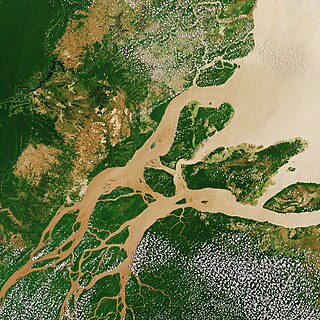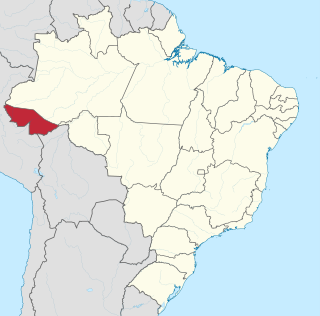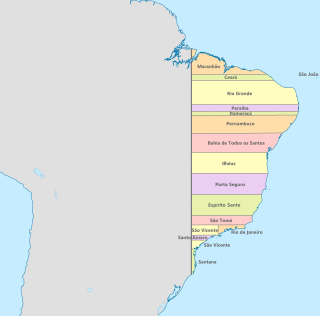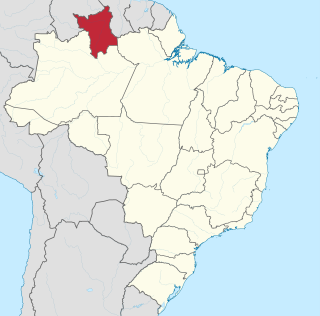
The Amazon River in South America is the largest river by discharge volume of water in the world, and the longest or second-longest river system in the world, a title which is disputed with the Nile.

Acre is a state located in the west of the North Region of Brazil and the Amazonia Legal. Located in the westernmost part of the country, at a two-hour time difference from Brasília, Acre is bordered clockwise by the Brazilian states of Amazonas and Rondônia to the north and east, along with an international border with the Bolivian department of Pando to the southeast, and the Peruvian regions of Madre de Dios, Ucayali and Loreto to the south and west. Its capital and largest city is Rio Branco. Other important places include Cruzeiro do Sul, Sena Madureira, Tarauacá and Feijó. The state, which has 0.42% of the Brazilian population, generates 0.2% of the Brazilian GDP.

Amazonas is a state of Brazil, located in the North Region in the north-western corner of the country. It is the largest Brazilian state by area and the ninth-largest country subdivision in the world. It is the largest country subdivision in South America, being greater than the areas of Chile, Paraguay, and Uruguay combined. Neighbouring states are Roraima, Pará, Mato Grosso, Rondônia, and Acre. It also borders the nations of Peru, Colombia and Venezuela. This includes the Departments of Amazonas, Vaupés and Guainía in Colombia, as well as the Amazonas state in Venezuela, and the Loreto Region in Peru.

Colonial Brazil comprises the period from 1500, with the arrival of the Portuguese, until 1815, when Brazil was elevated to a kingdom in union with Portugal. During the 300 years of Brazilian colonial history, the main economic activities of the territory were based first on brazilwood extraction, which gave the territory its name; sugar production ; and finally on gold and diamond mining. Slaves, especially those brought from Africa, provided most of the workforce of the Brazilian export economy after a brief initial period of Indigenous slavery to cut brazilwood.

The Rio Negro, or Guainía as it is known in its upper part, is the largest left tributary of the Amazon River, the largest blackwater river in the world, and one of the world's ten largest rivers by average discharge. Despite its high flow, the Rio Negro has a low sediment load.

Roraima is one of the 26 states of Brazil. Located in the country's North Region, it is the northernmost and most geographically and logistically isolated state in Brazil. It is bordered by the state of Pará to the southeast, Amazonas to the south and west, Venezuela to the north and northwest, and Guyana to the east.

The Jaú National Park is a national park located in the state of Amazonas, Brazil. It is one of the largest forest reserves in South America, and part of a World Heritage Site.

Manaus is the capital and largest city of the Brazilian state of Amazonas. It is the seventh-largest city in Brazil, with an estimated 2022 population of 2,063,689 distributed over a land area of about 11,401 km2 (4,402 sq mi). Located at the east centre of the state, the city is the centre of the Manaus metropolitan area and the largest metropolitan area in the North Region of Brazil by urban landmass. It is situated near the confluence of the Negro and Amazon rivers. It is one of the two cities in the Amazon Rainforest with a population of over 1 million people, alongside Belém.

The North Region of Brazil is the largest region of Brazil, accounting for 45.27% of the national territory. It has the second-lowest population of any region in the country, and accounts for a minor percentage of the national GDP. The region is slightly larger than India and slightly smaller than the whole European Union. It comprises the states of Acre, Amapá, Amazonas, Pará, Rondônia, Roraima, and Tocantins.

Pedro Teixeira, occasionally referred to as the Conqueror of the Amazon, was a Portuguese conquistador and military officer, who became, in 1637, the first European to travel up and down the entire length of the Amazon River, he also headed the government of the captaincy of Pará in two different periods, one in 1620-1621 and another in 1640–1641.

Theodor Koch-Grünberg was a German ethnologist and explorer who travelled and studied the Indigenous peoples in South America, in particular the Pemon of Venezuela and other indigenous peoples in the Amazon region extending South-Western Brazil and a large part of the Vaupés region in Colombia. The 2015 film El abrazo de la serpiente fictionalizes his illness and final days based on his journals.

The Amazon rubber cycle or boom was an important part of the socioeconomic history of Brazil and Amazonian regions of neighboring countries, being related to the commercialization of rubber and the genocide of indigenous peoples.

The history of the territory that is now Roraima, a state at the extreme north of present-day Brazil is recent, but not thereby simple. Invaded numerous times by the various countries interested in the region, the seldom-visited Roraima aroused little interest on the part of the Portuguese, especially after the arrival of the royal family in Rio de Janeiro. Meanwhile, the territory became coveted by other countries, including England, the Netherlands, and, especially, Spain.

Novo Airão is a municipality located in the state of Amazonas in northern Brazil on the Rio Negro River about 180 km upstream of Manaus. Its population was 19,928 (2020) and its area is 37,771 km2. The town is accessible by both river and road.

The Port of Manaus is a riverport located on the Rio Negro in Manaus, Amazonas, Brazil. The Port of Manaus is an important commercial center for ocean-going vessels traveling the Amazon. In fact, it is the main transport hub for the entire upper Amazon basin. It imports beef from the hinterlands and exports hides and leather. Important industries in the Port of Manaus include manufacturing of soap, chemicals, electronics equipment as well as shipbuilding, brewing, and petroleum refining.
The following is a timeline of the history of the city of Manaus, in Amazonas state, Brazil.
The Tupé Sustainable Development Reserve is a sustainable development reserve (RDS) in the state of Amazonas, Brazil.

The history of Manaus, with over 350 years of existence, coincides with the history of Brazil. The process of European occupation began in the middle of the 16th century, when explorer Francisco de Orellana arrived from Peru and intended to go to Spain.

The Tupinambá Uprising (1617-1621), also called the Tupinambá Revolt, took place on January 13, 1618, and was led by the tuxaua (cacique) Cabelo de Velha, who gathered several native indigenous groups from the busy Mairi region to fight against the Portuguese, due to the abuses committed by these colonizers when they exploited the indigenous labor force in the Conquest of Pará. This movement was one of a series of uprisings that took place in the region between 1617 and 1619. The disputes culminated in the attack in January 1619 by the Tupinambá on the Presépio Fort, located on the shores of Guajará Bay.

The history of Amazonas is the result of treaties, religious missions and a few indigenous rebellions in the Amazon territory. Initially, under the Treaty of Tordesillas, the site belonged to the Spanish Kingdom, but was later annexed by the Portuguese Crown. The state's international borders, undefined after Brazil's independence in 1822, were demarcated during the signing of the Treaty of Bogotá. Archaeological research suggests past occupations by Paleo-Indian hunter-gatherer groups, dated around 11,200 years before the present day.


















